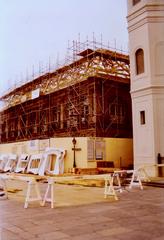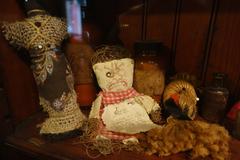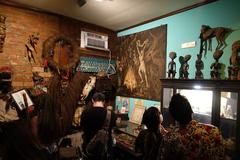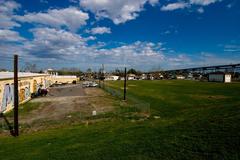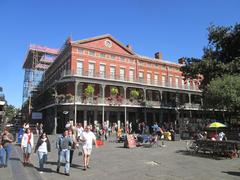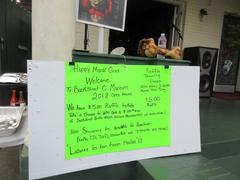
Comprehensive Guide to Visiting New Orleans, Orleans Parish, United States of America
Date: 13/08/2024
Captivating Introduction
Welcome to New Orleans, a city where every corner sings a unique melody and each street whispers tales of old. Imagine being enveloped by the aroma of freshly made beignets, the distant hum of a jazz trumpet, and the lively chatter of locals and visitors alike. New Orleans, famously known as the Crescent City, isn’t just a destination; it’s an experience that captivates all your senses. From its early days as a strategic French colony to its rebirth after the devastation of Hurricane Katrina, New Orleans has always been a city of resilience and celebration.
Founded in 1718 by Jean Baptiste Le Moyne, Sieur de Bienville, New Orleans quickly became the jewel of the French colonial empire, later passing through Spanish hands before being acquired by the United States in the Louisiana Purchase of 1803 (PBS). Its vibrant culture is a tapestry woven from the threads of its diverse inhabitants—French, Spanish, African, and Creole—all contributing to a unique cultural mosaic (Wikipedia).
Stroll through the iconic French Quarter and you’ll feel like you’ve stepped into another era. The Spanish-influenced architecture, the aroma of gumbo wafting from nearby restaurants, and the sound of jazz spilling out from Bourbon Street’s clubs create an atmosphere that’s both nostalgic and exhilarating. And let’s not forget Mardi Gras, a celebration that brings the city to life with parades, music, and a sense of community that’s palpable (Secret New Orleans).
But New Orleans isn’t just about its storied past and cultural vibrancy. It’s a place where you can lose yourself in the beauty of the Garden District, experience the thrill of a swamp tour, or uncover the secrets of its haunted history. Whether you’re a history buff, a foodie, a music lover, or an adventurer, New Orleans offers something for everyone. Ready to explore? Let’s dive into the heart of the Crescent City.
Table of Contents
- History of New Orleans
- A City Like No Other
- Early Foundations and Colonial Era
- Spanish Rule and the Great Fire
- The French Comeback and the Louisiana Purchase
- Statehood and the Battle of New Orleans
- Cultural and Economic Flourish
- Civil War and Reconstruction
- Jazz and Cultural Milestones
- 20th Century Developments
- Hurricane Katrina and Modern Era
- Resilience and Festivals
- Insider Tips and Local Secrets
- Significance of New Orleans
- Visitor Tips
History of New Orleans
A City Like No Other
New Orleans, famously known as the Crescent City, isn’t just a place; it’s an experience. Picture this: a city born out of strategic necessity, evolving into a cultural melting pot where every street echoes with melodies of jazz and the air is thick with stories. Intrigued? Let’s dive in!
Early Foundations and Colonial Era
New Orleans, or La Nouvelle-Orléans as it was once called, was founded in 1718 by Jean Baptiste Le Moyne, Sieur de Bienville. The French saw it as the perfect spot to control the mighty Mississippi River and establish a bustling trade port. Robert Cavelier, Sieur de La Salle, claimed the region in 1682, naming it Louisiana in honor of King Louis XIV of France. Imagine a young explorer, standing at the mouth of the Mississippi, dreaming of a grand city (PBS).
In 1723, New Orleans became the capital of the Louisiana colony. Its significance in the French colonial empire was undeniable. But the city’s control was like a game of hot potato among European powers. The Treaty of Paris in 1763 ended the Seven Years’ War, and voila, New Orleans was handed over to Spain (PBS).
Spanish Rule and the Great Fire
Under Spanish rule, New Orleans got a facelift, with architectural influences still seen today. But disaster struck on March 21, 1788. A massive fire razed over 850 buildings. Imagine the chaos and the subsequent Herculean efforts to rebuild (PBS).
The French Comeback and the Louisiana Purchase
In 1800, the secret Treaty of San Ildefonso saw France snatching Louisiana back from Spain. But the French reign was short-lived. In 1803, the United States bought the Louisiana Territory for $15 million, doubling its size in what is known as the Louisiana Purchase. Talk about a bargain! (PBS).
Statehood and the Battle of New Orleans
Louisiana joined the Union on April 30, 1812. Not long after, the Battle of New Orleans erupted in December 1814. General Andrew Jackson led American forces to a smashing victory against the British in January 1815, cementing New Orleans’ strategic importance (PBS).
Cultural and Economic Flourish
The 19th century was a golden era for New Orleans. In 1835, Congress authorized a U.S. Mint in the city, solidifying its economic muscle (PBS). Antoine’s, the oldest family-run restaurant in the country, opened in 1840, marking the city’s culinary rise (PBS).
Civil War and Reconstruction
New Orleans played a pivotal role during the Civil War. Louisiana seceded from the Union on January 26, 1861, but Union forces captured New Orleans on April 28, 1862. The city remained under Union control till the war ended (PBS).
Reconstruction saw Louisiana’s government passing a constitution in 1868 that expanded voting rights to black males and integrated public facilities. The state was readmitted to the Union on June 25, 1868 (PBS).
Jazz and Cultural Milestones
New Orleans is synonymous with jazz. Mardi Gras, with its modern form debuting in 1857 via the Mistick Krewe of Comus, adds to the city’s cultural tapestry (PBS). Louis Armstrong, born on August 4, 1901, emerged as one of jazz’s most iconic figures (PBS).
20th Century Developments
The 20th century was a rollercoaster for New Orleans. The 1853 yellow fever epidemic was a dark chapter, but the city also saw significant cultural and infrastructural strides. Preservation Hall, a jazz haven, opened in 1961 (PBS).
Hurricane Katrina and Modern Era
Hurricane Katrina, hitting on August 29, 2005, was devastating. Breached levees led to catastrophic flooding, and the Superdome became a refuge for thousands (PBS).
Resilience and Festivals
New Orleans is a city of resilience. Festivals like the New Orleans Jazz & Heritage Festival, which started in 1970, and the Satchmo SummerFest in August, celebrating Louis Armstrong, are testaments to its vibrant culture (Secret New Orleans).
Insider Tips and Local Secrets
Visiting New Orleans? Dive into the French Quarter’s hidden courtyards, savor a beignet at Café du Monde, and don’t miss the eclectic Bywater neighborhood. August is Museum Month, offering free entry to museums for members (Secret New Orleans).
For summer visits, expect high humidity and sudden showers. Pack light clothing and a small umbrella. Fine-dining spots like Commander’s Palace and Antoine’s have dress codes, so gentlemen, bring a jacket (TripSavvy).
Discover the Enchanting Heartbeat of New Orleans
A Journey through Time: History of New Orleans
Where It All Began: Early History and the Native American Era
Picture this: around 2200 BCE, the mighty Mississippi River laid down its silt, crafting the delta region that would become New Orleans. Imagine a bustling portage, known as Bulbancha (meaning “place of many tongues” in Choctaw), where Native Americans thrived for approximately 1300 years, trading goods and stories. Step back to 400 C.E., where archaeological whispers reveal settlements that mark the beginnings of this vibrant city (Wikipedia).
The Colonial Tapestry: French and Spanish Influences
French Colonial Period
In 1718, French colonists gave birth to La Nouvelle-Orléans, honoring Philippe II, Duke of Orléans. But like a plot twist in a gripping novel, the Treaty of Paris in 1763 handed Louisiana over to Spain, transforming it into Nueva Orleans. The city’s streets echo with French and Spanish melodies, a testament to its rich colonial past (Wikipedia).
Spanish Colonial Period
Under Spanish rule, New Orleans blossomed, with architectural marvels and street names that still whisper Spanish secrets. The city’s baton was passed back to France in 1800, and then to the United States in the dramatic Louisiana Purchase of 1803 (History.com).
The American Saga: 19th Century to Present
19th Century: The Port of Dreams
By the 19th century, New Orleans was the Southern belle of ports, exporting cotton and farm products across oceans. By 1840, it had climbed to be the third most populous city in the U.S. The Battle of New Orleans in 1815, a thrilling chapter in the War of 1812, solidified its strategic importance (Wikipedia). The Civil War saw Union forces swiftly capturing this Southern gem in 1862, disrupting the Confederacy’s lifelines (Britannica).
20th Century to Present: Resilience and Renaissance
In the 20th century, New Orleans danced to the rhythms of jazz, welcomed tourists with open arms, and celebrated life with grand festivals. Despite Hurricane Katrina’s wrath in 2005, the city’s spirit remained unbroken, rebuilding itself into the cultural powerhouse it is today (Wikipedia).
A Symphony of Cultures: The Cultural Significance of New Orleans
Music: The Birthplace of Jazz
New Orleans is the cradle of jazz, a genre birthed from a melting pot of European, Latin American, and African-American influences. From brass bands to rhythm and blues, the city’s music scene is a feast for the ears. Don’t miss the New Orleans Jazz & Heritage Festival, a vibrant celebration of this musical legacy (Wikipedia).
Cuisine: A Culinary Carnival
Let your taste buds dance with New Orleans’ signature dishes: beignets, po’ boy sandwiches, Gulf oysters, boiled crawfish, étouffée, jambalaya, gumbo, and red beans and rice. Each bite tells a story of Creole, Cajun, and French culinary traditions (Wikipedia).
Festivals and Events: The City of Celebrations
From the vibrant Mardi Gras to the soulful Jazz Fest, New Orleans knows how to throw a party. The Essence Music Festival, Southern Decadence, and Hexfest are just a few of the events that showcase the city’s diverse cultural tapestry (Wikipedia).
Insider Tips for an Unforgettable Visit
Best Time to Visit
For the perfect blend of pleasant weather and pulsating festivals, visit New Orleans from February to May. Fall, from October to November, offers cooler temps and fewer crowds. Summer’s heat and humidity come with perks: lower hotel rates and fewer tourists (TripSavvy).
Getting Around
Explore the French Quarter on foot, hop on the historic streetcars, or use rideshare services like Uber and Lyft. Renting a car? Only if you plan to venture beyond the city (TripSavvy).
Must-See Marvels and Hidden Gems
French Quarter: The Heartbeat of New Orleans
Stroll through the French Quarter, where every corner tells a story. Bourbon Street’s nightlife, Royal Street’s charm, and hidden jazz clubs await your discovery (PlanetWare).
Garden District: A Glimpse into Elegance
Wander through the Garden District, marveling at mansions and lush gardens. Don’t miss Lafayette Cemetery No. 1 and the iconic Commander’s Palace restaurant (Earth Trekkers).
Museums and Parks
Dive into history at the National WWII Museum, the New Orleans Museum of Art, and the Ogden Museum of Southern Art. City Park offers a green escape with its Botanical Garden and Carousel Gardens Amusement Park (Earth Trekkers).
Unique Adventures Await
Swamp Tours: Nature’s Serenade
Experience Louisiana’s wild side with a swamp tour. Glide through bayous, spot alligators, and immerse yourself in the natural beauty of the swamps (Earth Trekkers).
Haunted Tours: Ghostly Whispers
Uncover New Orleans’ eerie past with haunted tours. From ghostly pub crawls to spooky French Quarter tales, these tours offer a thrilling peek into the city’s darker side (Earth Trekkers).
Money-Saving Tips
Enjoy New Orleans on a budget by visiting free attractions like the French Quarter and City Park. Look out for free or low-cost music events and cultural experiences. Summer is budget-friendly with discounted flights and hotel rates (TripSavvy).
By embracing the history, culture, and insider tips for New Orleans, your adventure in this unique and vibrant city is just a heartbeat away. Ready to explore? Download Audiala, your ultimate tour guide app, and let the journey begin!
Visitor Tips for New Orleans
Welcome to New Orleans: The Crescent City Awaits!
Imagine a city where the air is thick with the scent of magnolias, where jazz melodies float through the streets, and the vibrant energy of every festival makes you feel alive. That’s New Orleans for you! Whether you’re here for Mardi Gras madness or a quiet winter escape, let this guide be your local friend with the insider scoop.
Best Time to Visit
The best time to visit New Orleans is from February to May when the weather is delightful, and the city is bustling with iconic festivals like Mardi Gras and the Jazz & Heritage Festival. Picture yourself basking in the sun with temperatures ranging from the 70s to mid-80s, perfect for parades and street performances (Travellers Worldwide). But beware, this is peak tourist season, so snag those flight and hotel deals early!
If you’re crowd-averse, December and January are your best bets. The weather is still mild, the holiday decor is enchanting, and the deals are sweeter than a beignet dusted with powdered sugar (Travel and Leisure).
What to Pack
Comfortable Shoes: New Orleans is a city best explored on foot. Pack those comfy shoes to wander through the historic French Quarter and the picturesque Garden District (Go Far Grow Close).
Stretchy Pants: With food so good, you’ll wish you had a second stomach. From po’boys to pralines, stretchy pants are your best friend (Go Far Grow Close).
Weather-Appropriate Clothing: Summer can be a sauna, so light, breathable clothing is key. If you’re visiting in winter, a light jacket will do the trick for those cooler evenings.
Getting Around
Public Transportation: Hop on the St. Charles Avenue streetcar for a scenic tour through the city. At just $1..25 per ride, it’s a steal! Day passes for $3 give you unlimited rides (The Vacationer).
Walking: Many attractions are just a stroll away from each other, especially in the French Quarter. The flat terrain makes it easy to navigate.
Biking: Rent a bike and pedal through history. Bike tours offer a fun way to see the city and learn about its rich past.
Safety Tips
Stay Alert: New Orleans is generally safe but stay aware of your surroundings, especially at night. Stick to well-lit areas and avoid walking alone late (Go Far Grow Close).
Mind the Gators: Planning a swamp tour? Keep an eye out for alligators. They’re fascinating but not to be underestimated (Go Far Grow Close).
Cash and Cards: While most places take credit cards, carrying some cash is handy for smaller vendors and street performers (Go Far Grow Close).
Unique Local Practices
Drinking Age: In Louisiana, you can legally drink at 18 if you’re with a guardian over 21. This is a bit different from most states, so cheers to that (Go Far Grow Close).
To-Go Cups: Why finish your drink when you can take it with you? Grab a to-go cup and sip as you explore (Go Far Grow Close).
No Closing Time: Bars here can stay open until the wee hours. Know your limits and drink responsibly (Go Far Grow Close).
Food and Drink
Must-Try Foods: Indulge in gumbo, jambalaya, beignets, po’boys, and chargrilled oysters. For dessert, pralines and king cake are non-negotiable, especially during Mardi Gras (The Broke Backpacker).
COOLinary New Orleans: Visit in August to enjoy budget-friendly, three-course meals at top restaurants during COOLinary New Orleans (New Orleans).
Brandy Milk Punch: Try this classic New Orleans cocktail for a refreshing, sweet treat (New Orleans).
Cultural Etiquette
Parades and Festivals: If you stumble upon a parade, join the fun! It’s a local tradition to share the joy with everyone.
Respect Local Traditions: New Orleans’ culture is a beautiful blend of French, Spanish, African, and Creole influences. Be respectful, especially during religious and cultural events.
Tipping: Tip 15-20% at restaurants, and 10-15% for services like taxis and tours. It’s the Southern way!
Additional Tips
Stay Hydrated: With the heat and humidity, keep water handy. It’s easy to get dehydrated.
Plan for Rain: Summer showers can be sudden. Carry an umbrella or raincoat and enjoy indoor attractions if it pours (New Orleans).
Sign Up for Updates: Stay in the loop with newsletters and insider guides to get tips, offers, and event info (New Orleans).
Time-Based Itineraries
A Day in the French Quarter: Start with beignets at Cafe du Monde, stroll through Jackson Square, explore the French Market, and end the day with live jazz on Frenchmen Street.
Explore the Garden District: Begin with a streetcar ride, admire the historic mansions, enjoy lunch at a local cafe, and visit Lafayette Cemetery No. 1.
Myth Busting and Surprises
Myth: Mardi Gras is just for adults. Fact: Mardi Gras has plenty of family-friendly parades and events.
Surprise: New Orleans has more than 130 festivals a year, so there’s always something to celebrate!
Call to Action
Ready to dive into the soul of New Orleans? Download Audiala, our tour guide app, to unlock the city’s secrets and stories. With beautifully crafted audio guides, insider tips, and hidden gems, Audiala will make your trip unforgettable. Happy exploring!
Call to Action
As you wrap up your journey through the enchanting lanes of New Orleans, one thing becomes clear: this city is a living, breathing entity, pulsating with life, music, and history. Its resilience in the face of adversity, from the Great Fire of 1788 to the devastation of Hurricane Katrina, is a testament to the indomitable spirit of its people (PBS).
New Orleans’ unique blend of cultures has given birth to a rich tapestry of traditions, from the soulful sounds of jazz to the delectable flavors of Creole and Cajun cuisine. Festivals like Mardi Gras and the New Orleans Jazz & Heritage Festival aren’t just events; they are immersive experiences that capture the essence of the city (Wikipedia).
But beyond the well-trodden tourist paths lie the hidden gems that truly define the Crescent City. Whether it’s the serene beauty of the Garden District, the eerie allure of its haunted tours, or the vibrant energy of its lesser-known neighborhoods, New Orleans always has something new to offer. Insider tips, like visiting during Museum Month in August for free entry to museums, or experiencing the city’s culinary delights during COOLinary New Orleans, can make your trip even more special (New Orleans).
New Orleans is not just a place to visit; it’s a place to immerse yourself in, to understand, and to fall in love with. And as you prepare for your adventure, don’t forget to download Audiala, your ultimate travel companion. With expertly crafted audio guides, Audiala will help you uncover the city’s hidden stories and secret spots, making your exploration of New Orleans an unforgettable experience. So pack your bags, follow the music, and let the spirit of New Orleans guide you. Laissez les bons temps rouler!
References
- PBS. (n.d.). Timeline: New Orleans. Retrieved from PBS
- Wikipedia. (n.d.). History of New Orleans. Retrieved from Wikipedia
- Secret New Orleans. (n.d.). Things to do in August in New Orleans. Retrieved from Secret New Orleans
- New Orleans. (n.d.). August in New Orleans. Retrieved from New Orleans


